General Electric history: from Edison's light bulb to the present day
General Electric is a bit like modern Internet startups. The company did not work in existing markets, but created new industries: sound recording, electricity, lighting and electrical appliances. The huge colossus of GE is the brainchild of the famous American inventor Thomas Edison. But its main merit is the creation of a laboratory for commercial research, on the principle of which modern R & D centers emerged.
Today we will talk about the "bright side" of the company, and in the next article about how General Electric built nuclear bombs, for which it was publicly criticized so much that it turned the units related to making a profit in this area.

General Electric booth at Pan American, 1901. A source
 The greatest inventor of America was born in the town of Milan, Ohio, February 11, 1847, in the family of a merchant and a teacher. The river Huron flowed near the city, and little Thomas already in his childhood showed an interest in water mills and other structures, in mechanics and biology. At the age of five, he tried to sit out goose and chicken eggs, learning that chickens hatch due to the heat of the bird. At school, teachers considered him limited, so he received home schooling. He enthusiastically read books in the People’s Library of Port Huron and did all the experiments from Richard Green Parker's “ Natural and Experimental Philosophy ”.
The greatest inventor of America was born in the town of Milan, Ohio, February 11, 1847, in the family of a merchant and a teacher. The river Huron flowed near the city, and little Thomas already in his childhood showed an interest in water mills and other structures, in mechanics and biology. At the age of five, he tried to sit out goose and chicken eggs, learning that chickens hatch due to the heat of the bird. At school, teachers considered him limited, so he received home schooling. He enthusiastically read books in the People’s Library of Port Huron and did all the experiments from Richard Green Parker's “ Natural and Experimental Philosophy ”.
Thomas began to work early - first he helped his mother sell vegetables and fruits, and then he got a newspaper on the Port Huron-Detroit railway line, where he received up to $ 10 a month for which he could barely live. He was looking for different ways to increase the sales of newspapers, and one of them called a request to inform all stations of the line in 1862 about the defeat of the commander-in-chief of the northern army. As a result, at each station, passengers wanted to know the details about this news - this was the part of the enterprising Edison. In one of the baggage cars, Edison equipped the laboratory. Later, because of experiments with phosphorus, his first laboratory burned down. With this incident, perhaps, is associated and partial hearing loss. Of course, complications after scarlet fever could be the cause, since antibiotics did not exist in the 19th century. But Edison himself said that he was deaf from the blow of the conductor in the ear after the explosion in this laboratory.
From 1863, Edison worked as a telegraph operator. Working the night shift, he slept thanks to the automation of processes. It cost him the job: at one point, because of this, two trains almost collided. Edison took over as a day shift telegraphist at Fort Wayne, and then got a job at Western Union. At that time, he was simultaneously developing an “electric ballot apparatus” —a prototype of the modern e-democracy of the 19th century — and an apparatus for automatically recording exchange rates.
An improved version of the telegraphing system for stock exchange bulletins on the gold and stock price by applying the exchange ticker was acquired by the society Gold and Stock Telegraph Company for 40 thousand dollars. With this money, Edison founded Pop, Edison and Company, and bought equipment for making stock tickers. Over the course of the year, he will improve the telegraph, increasing the speed from 40–50 to 200 words per minute, a typewriter, solve the problem of the quadruple complex for telegraphy and open two new workshops.
But Edison needed not just a workshop. He needed a real R & D center, which he opened in Menlo Park.
In 1876, the construction of a two-story laboratory in Menlo Park in New Jersey was completed, for which Edison spent $ 2.5 thousand. It is difficult to perceive the amount of the last century, but today it is about $ 60 thousand . Since 1954, this town is called Edison in honor of the inventor, and a museum is housed in a copy of his laboratory building.

Thomas Edison Laboratory at Menlo Park, 1878
Edison was completely absorbed in work. So much so that after the wedding and the birth of two children he constantly remained in his laboratory, and to protect the house he bought a newfoundland and two smaller dogs. To protect the property, his wife had to sleep in a three-story house with a revolver under the pillow.
Thomas Edison initially wanted to put the invention on stream. He promised in his new laboratory to do "small inventions every 10 days and big things every six months or so." According to this model, R & D centers in the USA and other countries are now operating.

The first floor of the laboratory, 1878
In a letter to the president of Western Union, William Orton ( William Orton ), Edison described his laboratory as follows :
“The building is 25 × 100 feet, two floors of which are filled with almost all scientific research equipment. And I have a machine shop with a five-horsepower engine. Equipment is the best. I hired three workers, two of whom have been working with me for five years and have a lot of experience. I also have two assistants who have been with me for five and seven years, both highly qualified employees. ”
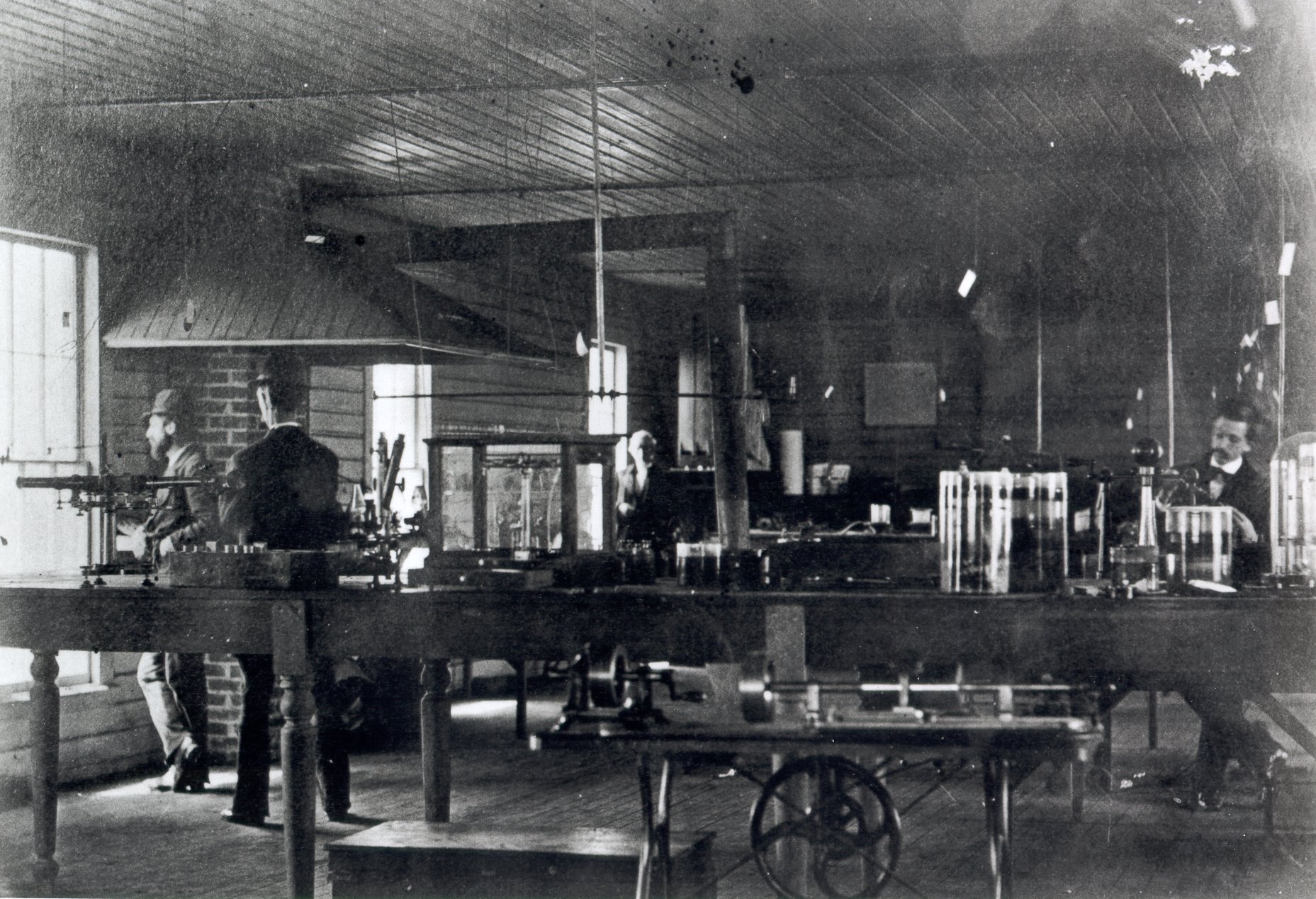
The second floor of the laboratory, 1878
The letter went to Western Union - Edison needed money. Only coal kerosene and staff salaries took about $ 100 a week. Edison promised to give the company "every invention I make during the financing period and which will be applicable to commercial telegraphy." Western Union agreed to take on patent spending and pay royalties for successful inventions, including telephone.
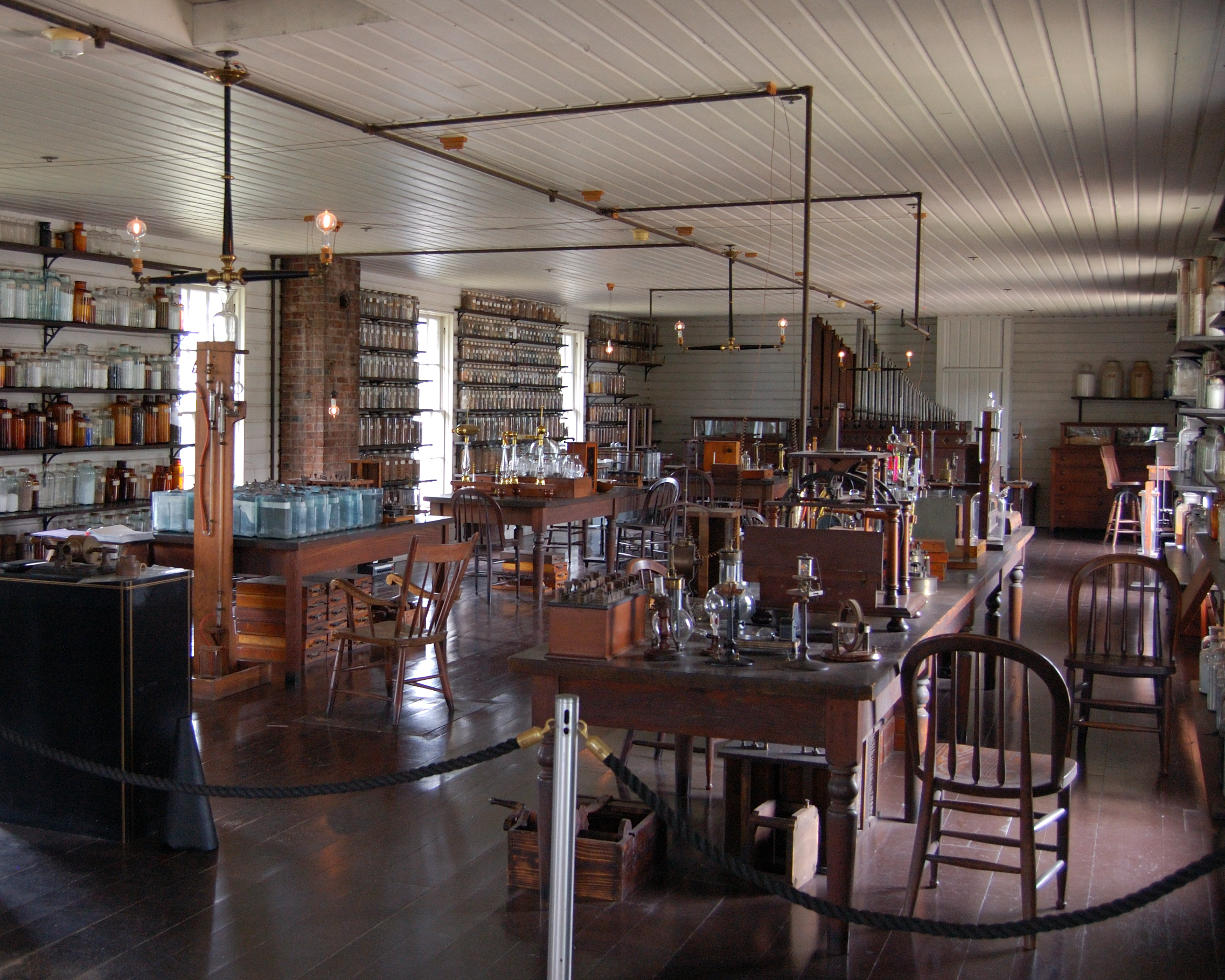
The second floor of the Edison Museum. Pay attention to the organ at the far wall. Photo: Andrew Balet
"The Menlo Park Wizard" by Thomas Edison made the invention of the phonograph.
In August 1877, Edison wrote down a line from the poem “Mary had a lamb,” and the phonograph successfully reproduced the words. Edison commercialized the invention, showing it to people, and then sold the rights to manufacture a phonograph for $ 10,000.
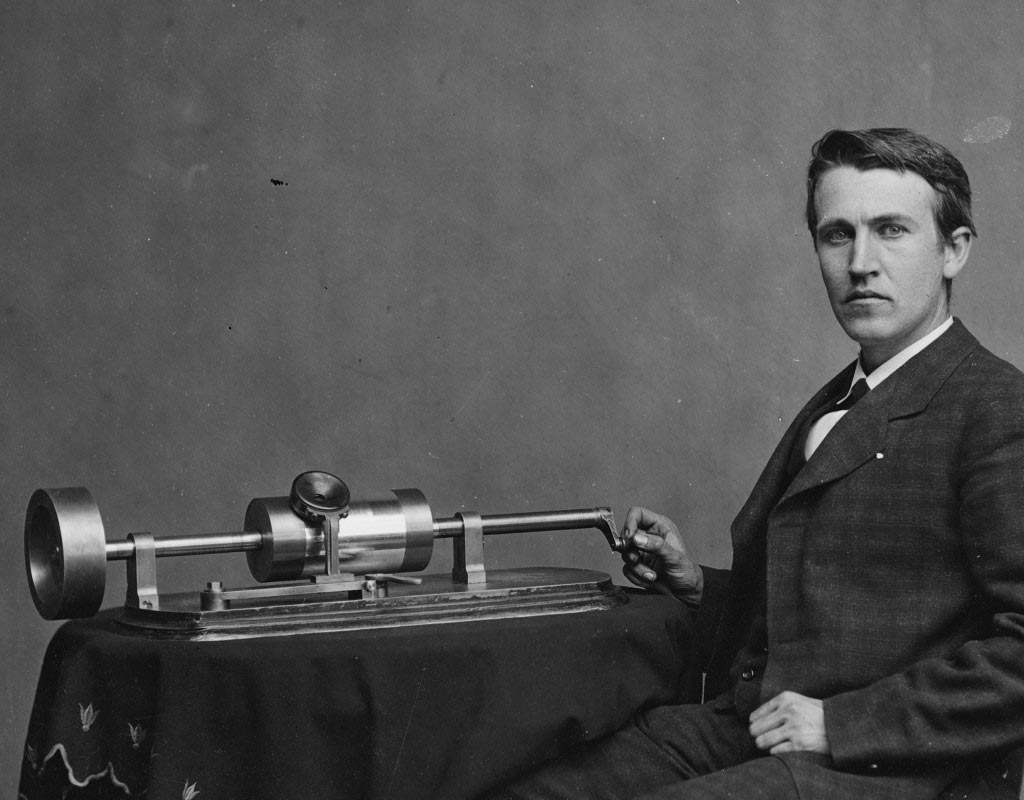
Thomas Edison and Phonograph
“Once, when I was still working on improving the telephone, I somehow sang over the diaphragm of the telephone, to which a steel needle was attached. Thanks to the trembling of the plate, the needle pricked my finger, and it made me think. If it were possible to record these oscillations of the needle, and then again to hold the needle on this recording, why not record the disc, "- said Edison.
The brass roller of the phonograph was wrapped with a thin tin foil, along which the sharp end of the needle squeezed out sound waves. When scrolling through the recording roller, the needle and membrane vibrate and reproduce sound. Later, instead of foil, Edison began to use wax. One of the first recordings of his voice with a song about Mary and the lamb has been preserved to this day .
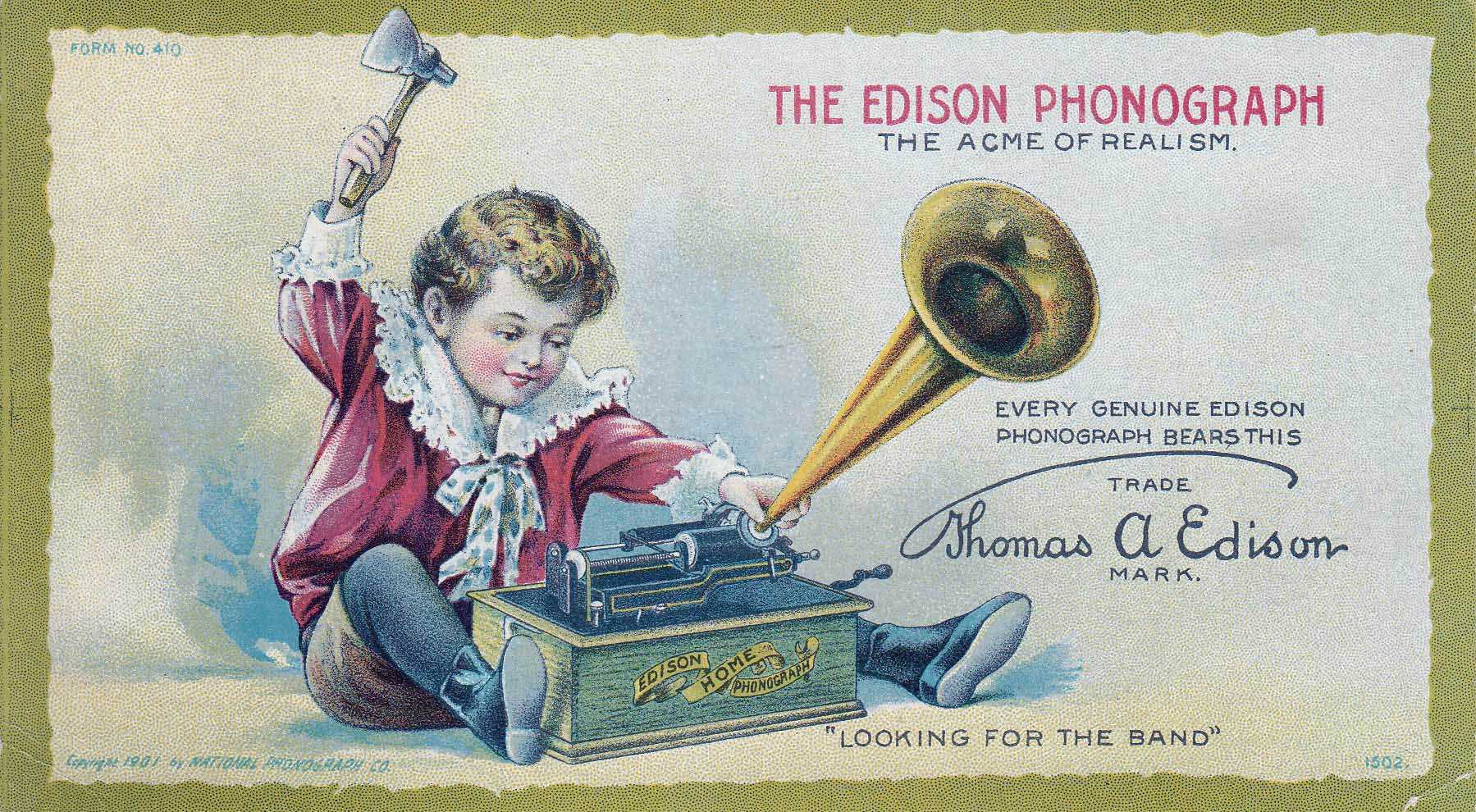
Phonograph Advertising, 1901
Edison suggested several ways to use the phonograph, including audio books for the blind, audio tutorials, recording music and speeches of great people. In Russia, one of the first users of the invention was Leo Tolstoy. The recording of his voice also reached us thanks to Edison's phonograph.
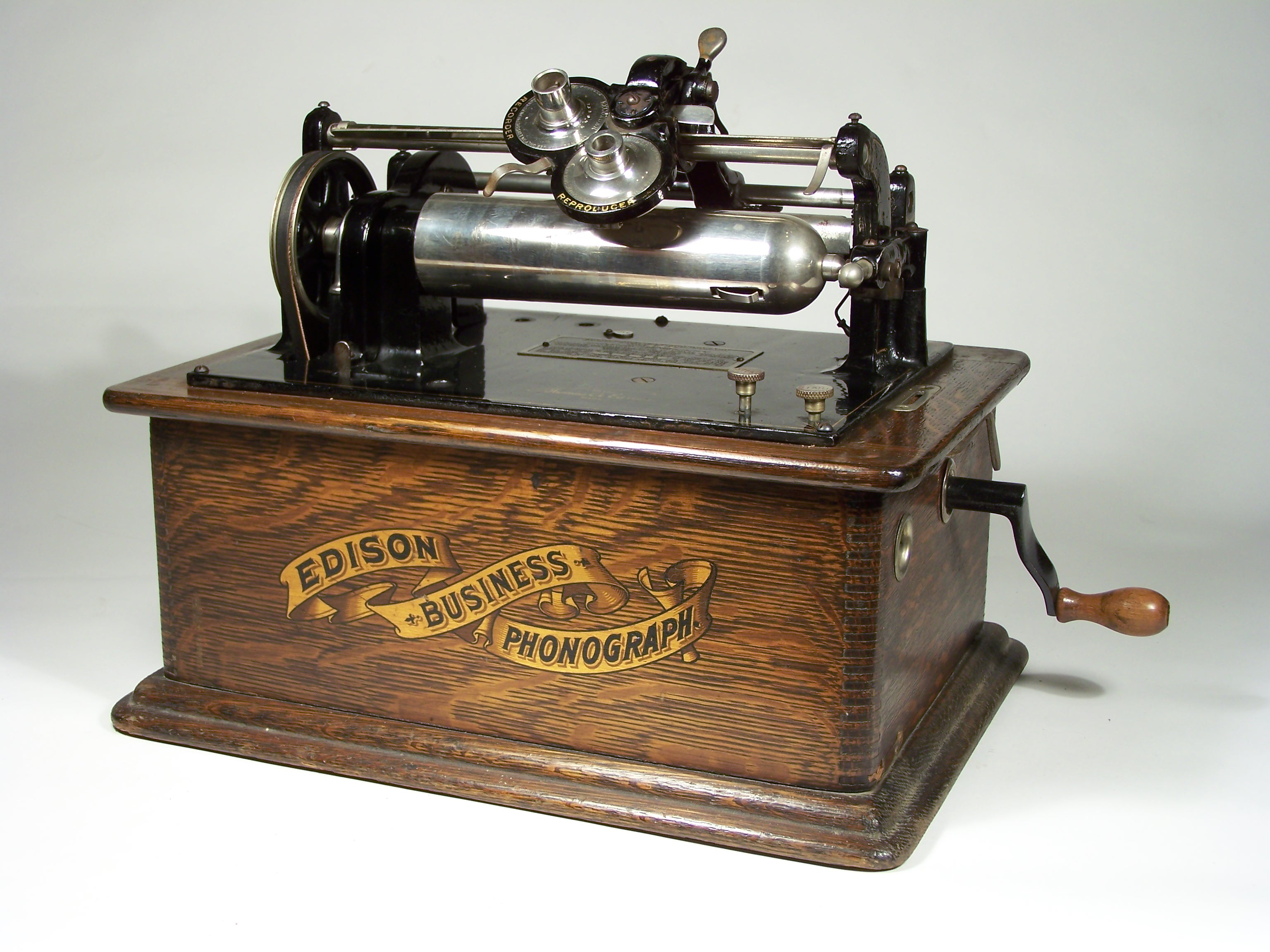
One version of the phonograph
In 1903, Edison founded one of the first record labels - Edison Records. By that time, instead of wax cylinders, Blue Amberol cylinders and Edison's Diamond Disc flat discs were used.
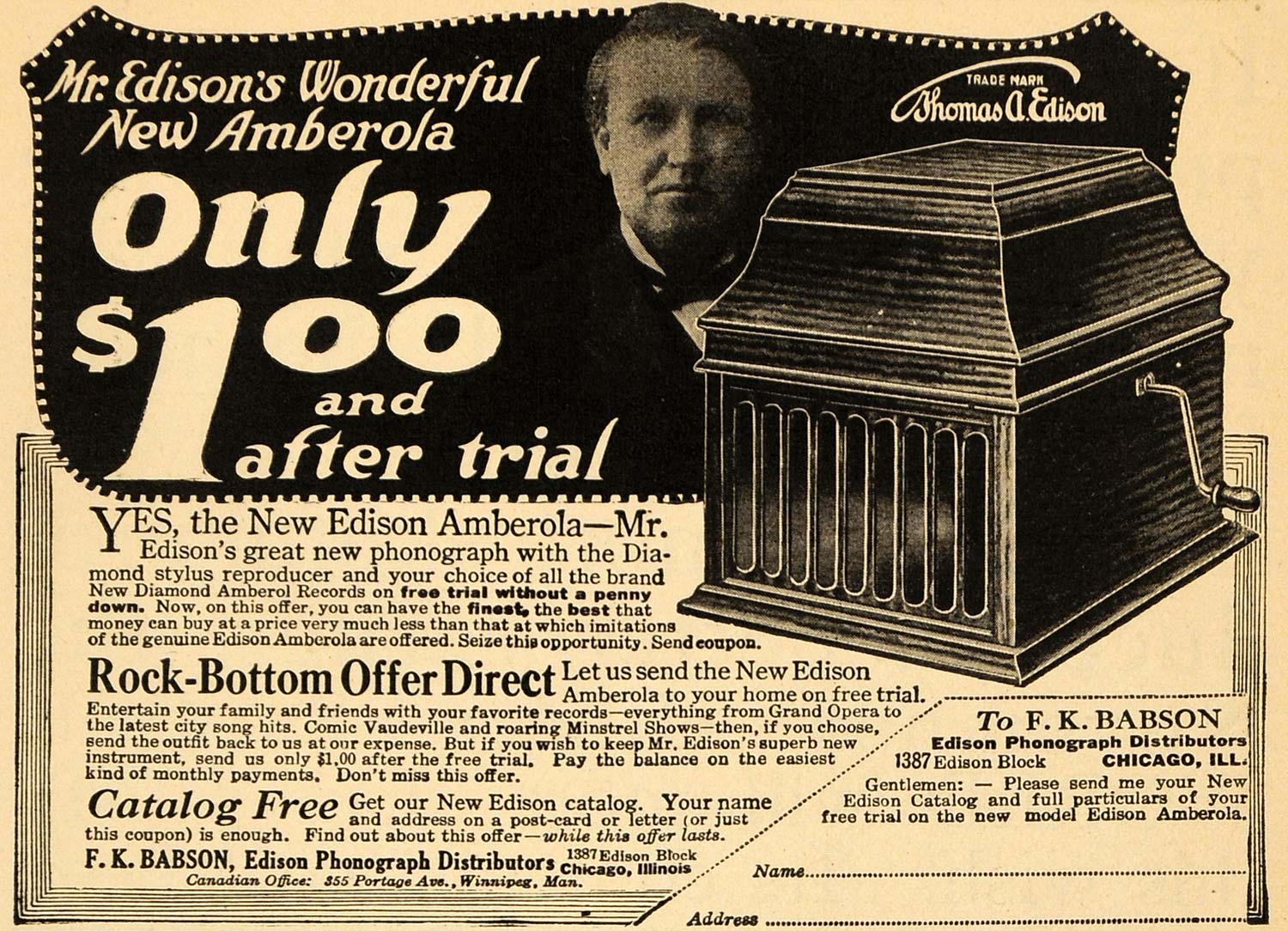
Amberola
In parallel, the gramophone produced by Emil Berliner was distinguished by the ease of replicating records and initially louder sound. Therefore, by 1929, the phonograph and the Amberola were practically ousted from the market, and Edison Records was closed. But in 1878, revenues from the Edison Talking Phonograph and Western Union funding enabled the company to increase the number of employees to 25 people, including experimenters, a caretaker, a personal secretary, and machinists. Edison founds Edison Electric Light.
In 1878, Thomas Edison began working on an electric lighting system. He tried to find a replacement for gas and oil lamps and candles, which at that time were the main sources of lighting in homes. Before Edison, they tried to apply electric current for lighting, but no one was able to achieve a long lamp life and commercial success. By 1879, Edison's record was 13.5 hours of work. In this lamp, he used carbonized Japanese bamboo as the filament. To find this material, his laboratory experimented with silk, paper, cardboard, nutshells, and employees brought reed and palm wood from distant countries.
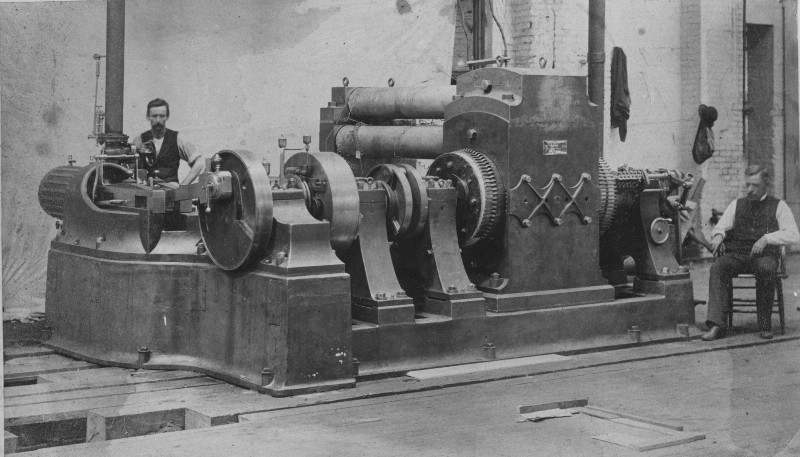
Pearl Street, New York steam power plant, established in 1882
The next stage was the power supply system, which, according to Edison's plan, included underground communications with backup lines in case of breakdowns, wiring for buildings, a generator and a power plant with steam engines. Already in September 1882, New York switched to incandescent bulbs, which were powered by direct current from a power station built by Edison. The construction involved in the Edison Illuminating Company. In the autumn of the same year, the power plant appeared in Shamokin, Pennsylvania, and was built by the Edison Electric Illuminating Company of Shamokin. Similar companies began to appear in other cities of the USA, and then in Europe.
Together with the companies appeared a lot of jobs. In 1891, Henry Ford came to the Edison Illuminating Company, he worked as an engineer. In his spare time, he designed his first car.
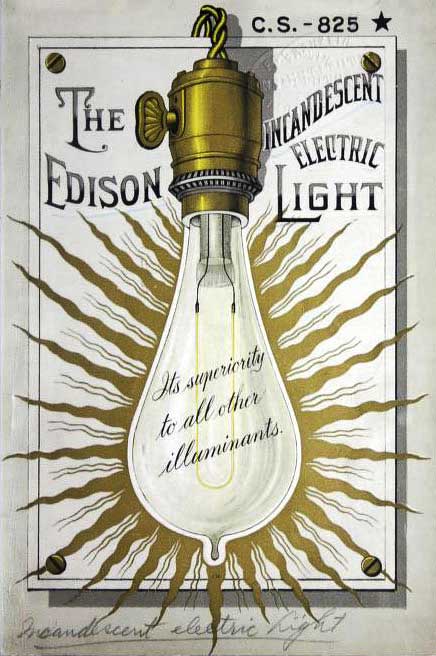
1887 advertising
Now we have to go back a couple of decades ago to St. Petersburg, where Alexander Nikolaevich Lodygin in 1873 conducted the first experiment on lighting the streets with electric incandescent bulbs, in 1876 - illuminated the windows of the fashionable laundry shop Floran. In two months, only two of the four rods burned out. The lamp life was up to 700–1000 hours. In 1874, from the Academy of Sciences Lodygin received the Lomonosov Prize in the amount of a thousand rubles. But "The Russian Electric Lighting Association Lodygin and Co." soon went bankrupt, Lodygin did not receive sufficient support and funding, and emigrated to the United States.
In 1890, Lodygin received a patent in the United States for the use of a metal filament - from tungsten, osmium, iridium and palladium - in electric incandescent lamps. In 1906, Lodygin sold his patent to General Electric, and Edison began commercially producing an improved version of the lamp.

Lamp Lodygina
It is not enough just to sell light bulbs, especially when there is not electricity everywhere. It is necessary to make people use electricity more and more often, so that they could not imagine their life without it, including home life. Due to electrification, General Electric created a virtually unlimited market in which it could dominate before the appearance of competitors. In the following decades, toasters and refrigerators settled in the kitchens.
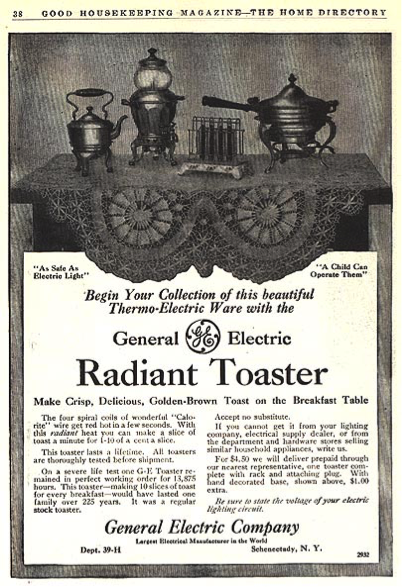
Advertising toaster General Electric D-12
The fridge from the advertisement below was named after the French engineer Marcel Audifren, who patented this device in 1895. At the time of the publication of this advertisement, according to what was written in it, Edison's refrigerators were installed in one and a quarter million American homes. Such a unit cost 300 US dollars (about 4,000 dollars in terms of today), but was three times cheaper than its competitors. These were the first commercially successful refrigerators in the world. By 1962, 98.3% of families in the United States, 20% of families in Italy, and 5.3% in the USSR used refrigerators. And this is largely the merit of General Electric.
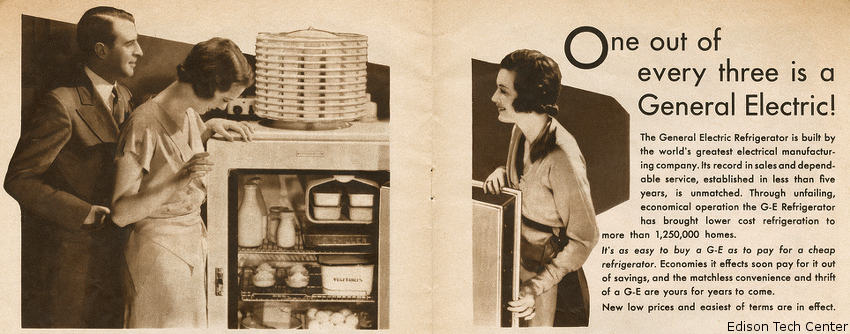
General Electric fridge ad
One of the most important areas today is medical equipment. In 1885, in the process of studying cathode rays, Wilhelm Conrad Roentgen discovered new radiation and called it X-rays , and in December of the same year published an article “On the new type of rays”. The following year, Victor Electric built the X-ray unit and suggested using it to diagnose bone fractures and detect foreign objects in the human body. Over the next twenty years, a number of other companies producing similar equipment appeared, and in 1916 Scheidel Western, Snook-Roentgen, MacAlaster & Wiggin and Victor Electric Co merged under the name of the latter. In 1920, General Electric bought the Victor Electric thus formed and entered the market shortly before World War II, when X-ray radiation was actively used to test materials without damaging them. Today, the industry is engaged in a subsidiary of General Electric - GE Healthcare.

In 1960, the Soviet scientist Vladislav Ivanov sent an application for a patent "Method of determining the internal structure of material bodies", where he described the principles of the tomograph and its scheme. The story did not get continued. The American scientist Raymond Damadian in 1973 wrote about the results of his research, according to which tumors and normal tissues react differently to nuclear magnetic resonance, and suggested using the technology for early diagnosis of cancer, and then received a patent for it.
One of the first companies to see potential in technology was General Electric. In 1983, the company was the first to develop a magnetic resonance imaging apparatus and scan the human brain for the first time in the world. This development was another successful example of the commercialization of technology by General Electric.
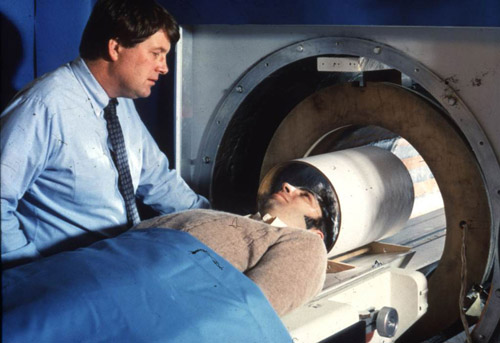
The first broadcast of the voice signal over the Atlantic radio and the first telecast in the USA in 1927 are also connected with the name of Ernest Alexanderers . A scientist of Swedish descent from the age of 24 he worked at General Electric. In the United States, under the influence of the president of the country, who did not want a foreign monopoly in the states, did not use the alternators of the Italian Marconi, and instead of them on the American radio stations used alternators of Alexander’s.
General Electric founded the diversified corporation RCA in 1919, which is responsible for the world's first commercial network broadcasting NBC. The company sold televisions and other electronic devices, including video players on discs.
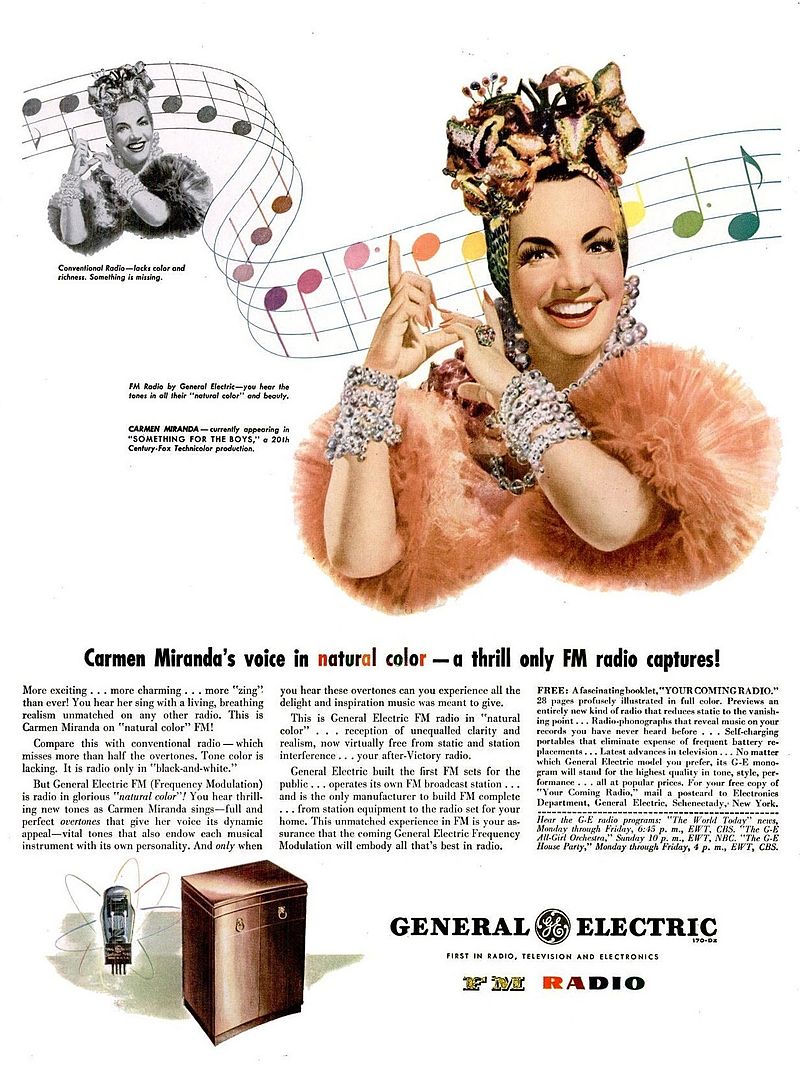
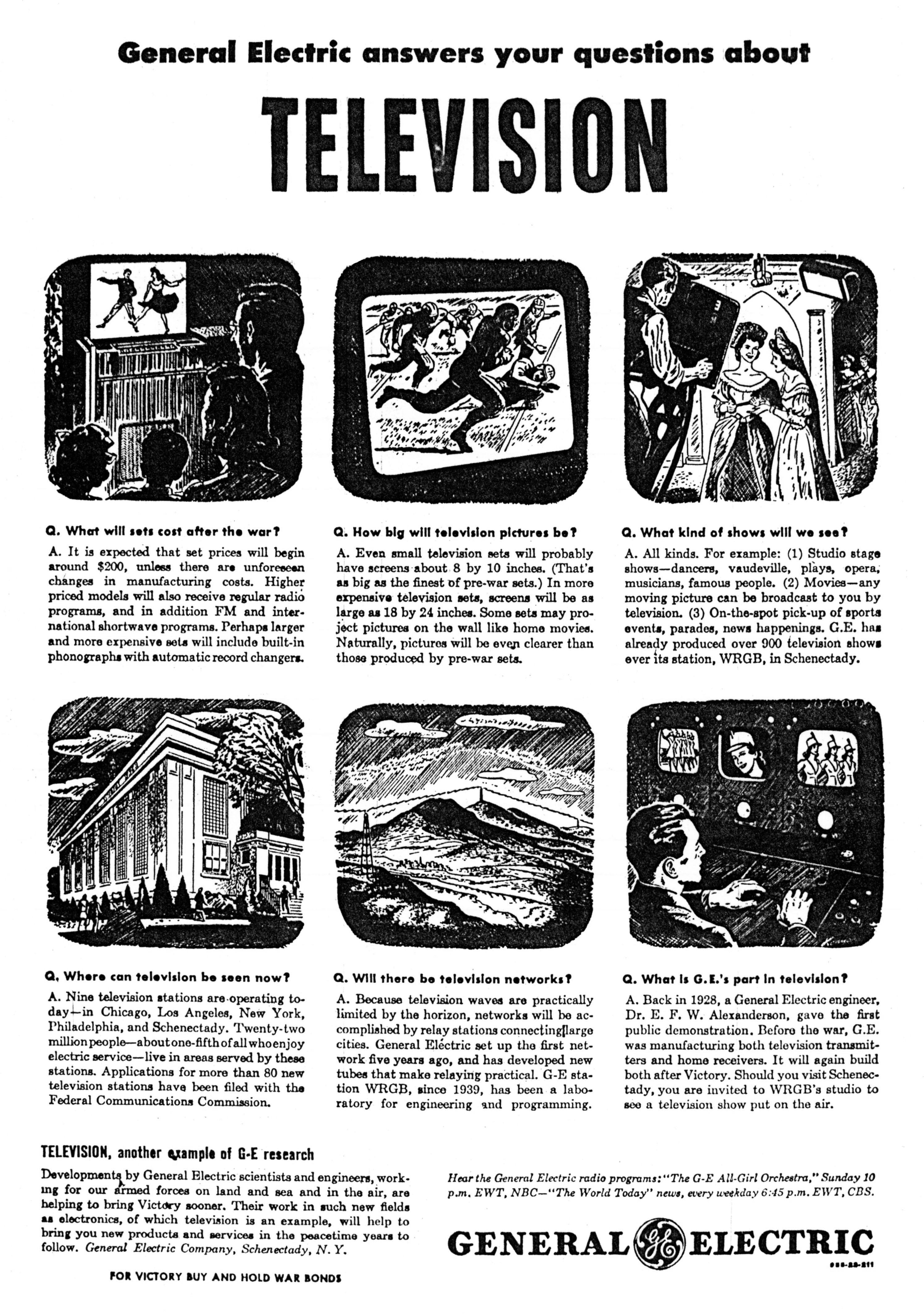
In the 1950s, GE was one of the main users of computers, and in the 1960s, it entered the market with a line of highly specialized computers. The company also developed software: in 1962, it began developing the GECOS operating system, some versions of which are used today.
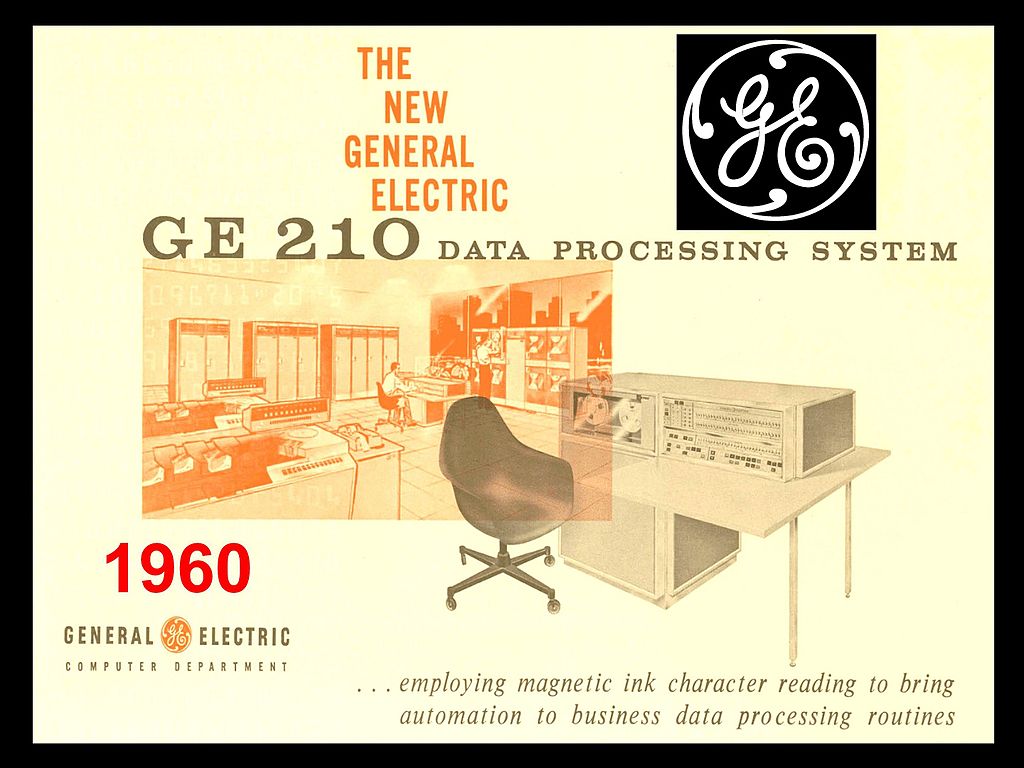
In the 1960s, about 6,000 General Electric employees participated in the Apollo program . Among their developments is a particularly durable rubber for the sole of astronauts' boots and transparent Lexan, from which the visors of spacesuit helmets were made.
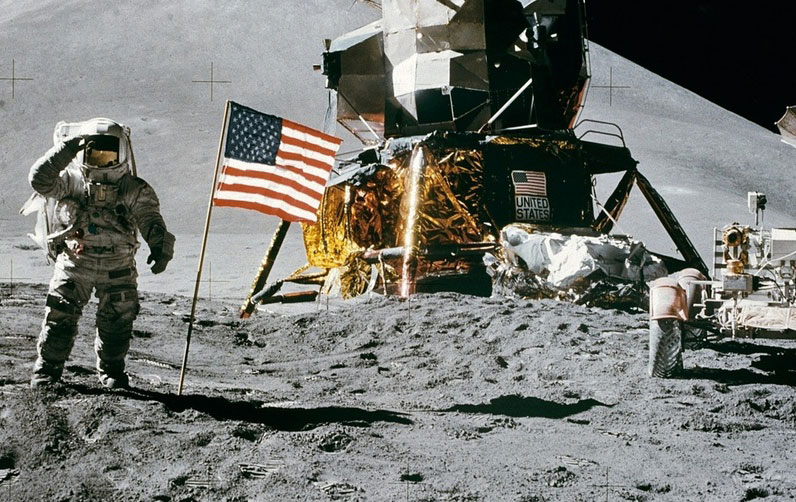
Not only Henry Ford went through the work with Thomas Edison. One of the employees of General Electric was Nikola Tesla . While studying at a higher technical school in Austria, Tesla drew attention to the imperfection of DC machines, but Professor Jacob Peschl criticized his opinion by giving a lecture on the impossibility of using alternating current in electric motors. Later, Tesla learned one course at the Faculty of Philosophy of Prague University, worked as an electrical engineer in a government telegraph company in Budapest. At the end of 1882, he came to the Continental Edison Company in Paris, where he also worked on the construction of a power station for the railway station in Strasbourg.
Young Tesla was distinguished by trust in people, which is why he repeatedly attacked the same rake. At the Continental Edison Company, he did not receive $ 25,000 for solving a number of problems associated with the construction of a power plant. He quit and left for the United States, where he did not receive the $ 50,000 prize promised by Edison himself for 24 improved versions of the DC machine - Edison said that the immigrant poorly understands American humor. And Tesla quit again. But after that, he contacted a group of people for whom he had developed a project for an arc lamp for street lighting. In the end, he was offered not money, but a stake in a new company that was to exploit the technology.
In 1887, Tesla was able to find the money and opened the Tesla Electric Company, starting to work on street lighting using arc lamps of his own invention. Tesla's office was not far from Edison's company in New York. The well-known "War of Currents" began. But do not take it as a confrontation only Tesla's young genius and cunning entrepreneur Edison. Soon, a film describing these events, which is called “ The War of Currents ”, is coming out. But, as can be seen from the trailer, in the center of the plot is Edison’s struggle not with Tesla, but with George Westinghouse for the US electricity market.
George Westinghouse, a veteran of the US Civil War, began his career working in the workshops of a railway company. In the list of his inventions is a device for lifting wagons that have come off the rails. Already after the inventor launched his own car-repair workshops, his pneumatic brake for the cars allowed him to start his own business - the Westinghouse Air Brake Company. Westinghouse invested revenues from this business in the company Westinghouse Electric and Manufacturing Company, for which he bought 40 patents for alternating current electrical equipment from Nikolay Tesla.
When transmitting direct current over long distances, a significant amount of energy is lost, this method is effective only at a distance of one and a half kilometers from the power station. To solve this problem, you need to use copper wires of large cross section or locate generators closer to consumers - this will require a lot of local stations. And alternating current can be transmitted over long distances using high-voltage lines. Despite this clear advantage of the technology used by Westinghouse, Edison did not give up - he started an “information war”.
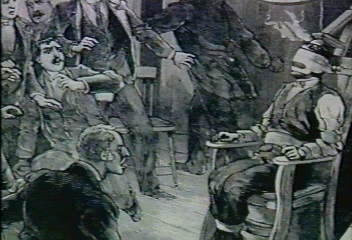 Thomas Edison started with the ships that he lost. He continued with black PR: he tried to put Westinghouse as a murderer, and the alternating current was deadly for people. Edison and his supporters began developing a humane method of execution, which was supposed to replace hanging, and recommended using alternating current for this. Westinghouse tried to save the defendant to avoid a public demonstration of the AC murder, and hired lawyers for William Kemmler , who killed his wife with an ax. Westinghouse refused to sell generators for this "event", but they still managed to get it. The execution took place, and Westinghouse commented on her as follows: "They would have done better with an ax."
Thomas Edison started with the ships that he lost. He continued with black PR: he tried to put Westinghouse as a murderer, and the alternating current was deadly for people. Edison and his supporters began developing a humane method of execution, which was supposed to replace hanging, and recommended using alternating current for this. Westinghouse tried to save the defendant to avoid a public demonstration of the AC murder, and hired lawyers for William Kemmler , who killed his wife with an ax. Westinghouse refused to sell generators for this "event", but they still managed to get it. The execution took place, and Westinghouse commented on her as follows: "They would have done better with an ax."
Another execution that was supposed to sow the fear and horror of alternating current in people's minds was the execution of Topsy, the elephant. The animal killed several people, including the trainer - did not want Topsy to eat a lit cigarette. During the execution, an elephant current of 6600 volts passed through the body of the elephant. Edison employees filmed what was happening on a movie camera.
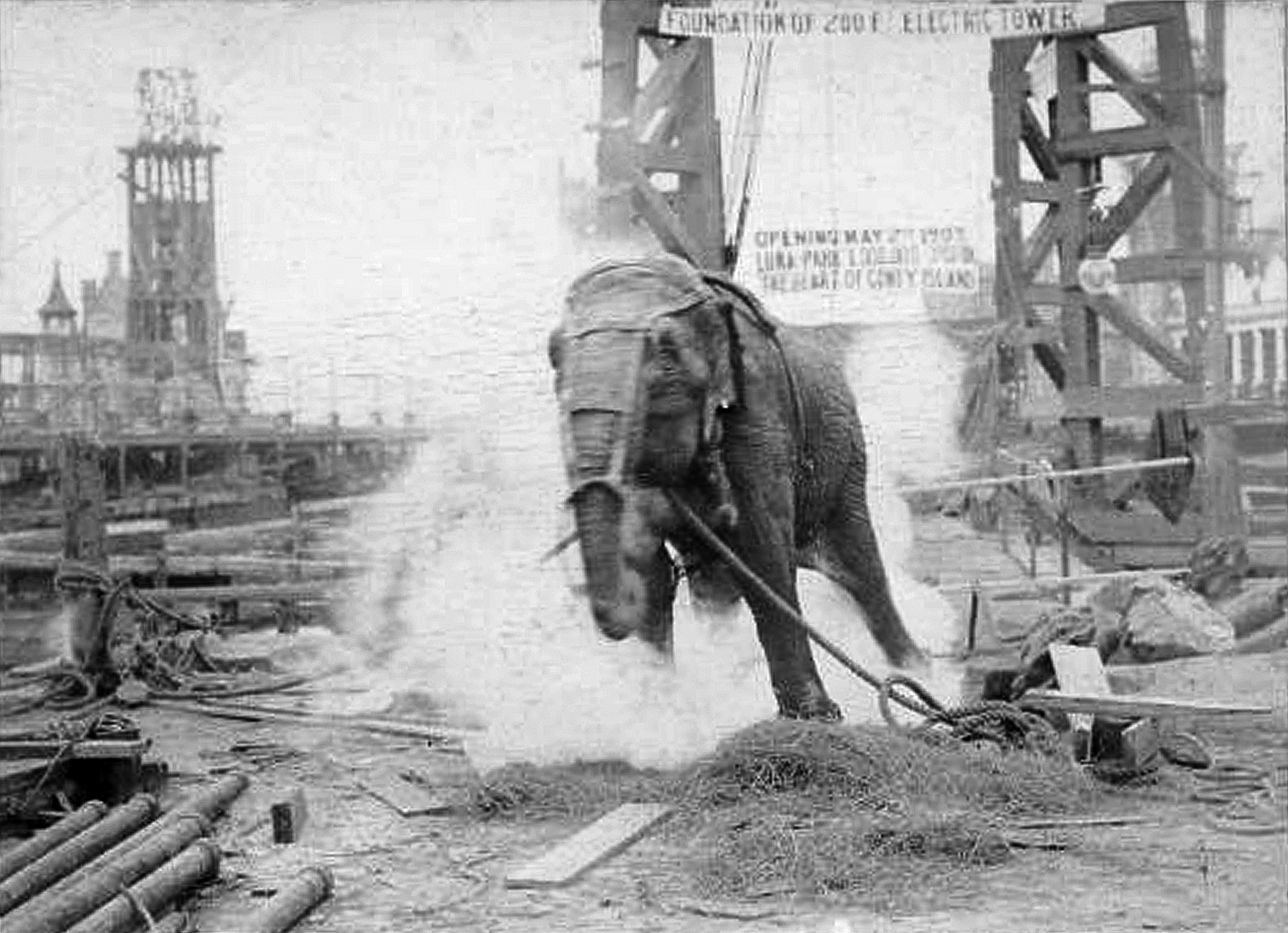
In 1892, Edison Electric Light teamed up with the Thomson-Houston Electric Company to fight a major competitor. The new company was named General Electric . The fact that the Thomson-Houston Electric Company was engaged in developments in the field of alternating current, but Edison did not abandon the strategy of denigrating this technology, is surprising here. He contributed to the spread of news about the deaths of careless handling of electricity.
Nikola Tesla found a way to show that Edison is wrong and that alternating current is not unmanageable and dangerous. The Westinghouse company won a tender for coverage of the World Exhibition in Chicago in 1893. Tesla prepared a show in which he passed a current of two million volts through himself, light bulbs were lit in his hands, and at the same time he remained alive.

This was the first step towards Tesla’s worldwide fame. The next step was a truly ambitious project - a power station at Niagara Falls. Two-phase alternators of alternating current construction designed by Nikola Tesla were eventually installed at hydroelectric power plants. In 1896, the first launched unit provided with electricity several factories and plants, and also launched a three-phase overhead line 40 km long to Buffalo. For this we had to install step-up transformers.
Tesla with its alternating current could be called the winner in the war, when in 2007 the last direct current consumers were cut off from the network in New York . Today, alternating current is omnipresent, and a constant one is obtained from it by necessity. In such cases, it does not leave the limits of the devices. Direct current can be found in solar energy: a solar battery is a direct current generator that charges a battery. But then with the help of an inverter, the energy is converted into the same alternating current. Direct current is needed for underwater energy transfer, and it is also used in transport.
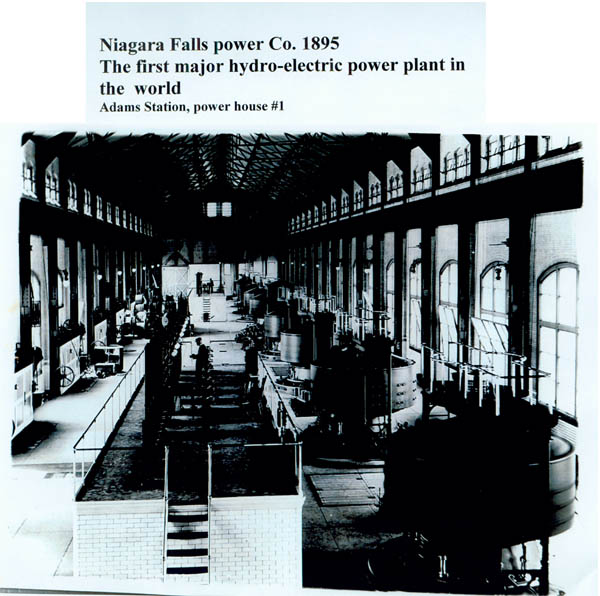
Innovations are built on two tenets: invention and commercialization. An invention that does not promise profit remains a mere invention. Thomas Edison, who in 1930 became a foreign honorary member of the USSR Academy of Sciences, did not manage his own company since the 1890s.He devoted all his time to inventions and thinking through ways of their commercialization.
Edison managed to find a recipe in which people create new products in one laboratory and solve problems related to their use. He collected the best scientists and inventors from all over the world to work in his R & D center. Among them were Henry Ford, Nikola Tesla (with him Edison, of course, so costlessly), Nobel Prize winners Irving Langmuir and Aivar Jayever . “A small improvement every 10 days, a great invention every 6 months,” with such well-defined KPIs, the company created new industries and remained one of the most reliable and profitable in the world for more than a hundred years.
Today, the company continues to produce household appliances - refrigerators, washing machines, dishwashers, cookers and microwave ovens. But the main income of GE comes from energy and aviation - a quarter each. The company produces electric motors and digital solutions for this industry. GE was the first in the history of the United States to make a jet engine. Innovation never stops: more recently, the company introduced a 3D printer to print aircraft parts .

3D printer for printing aircraft parts
General Electric is one of the largest manufacturers of MRI and other medical equipment, lighting, oil and gas production and processing, financial services, renewable energy and transportation — for example, trains. In every area, General Electric is trying to use the latest developments, including the use of “virtual twin” parts in engines, wind turbines and other machines to predict their wear and replace before they break.
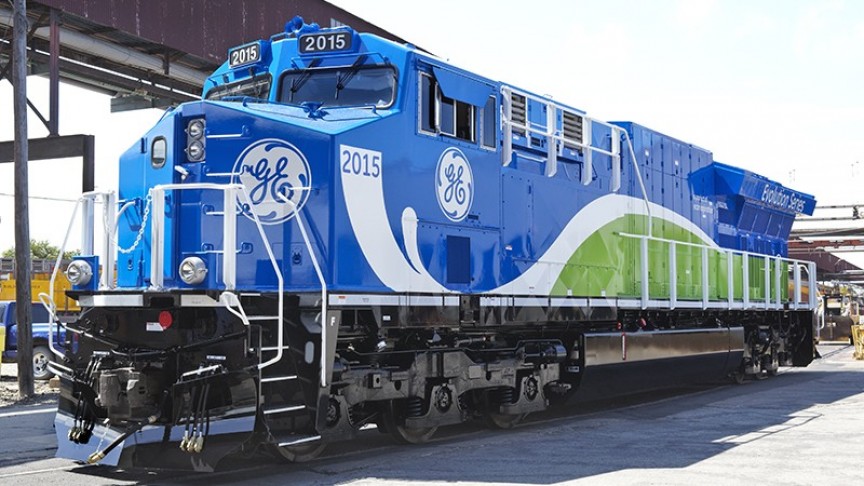
But now GE is going through hard times. In 1998, 1999 and 2000, GE was recognized as the most influential company in the world, and on Wall Street the saying went: “If you want to invest, but you don’t know what to invest in, buy General Electric.” And in 2017, Warren Buffett gets rid offrom all shares of General Electric. From the beginning of 2017, the company's shares fell from $ 31.63 to $ 18.43 per share.
In November 2017, it became known that the new head of the company, John Flannerty, wants to dismiss nine members of the board of directors from the age of eighteen and hire professionals who can breathe new life into the company and stop the fall in stocks. Perhaps they will be able to regain GE former glory.

Today we will talk about the "bright side" of the company, and in the next article about how General Electric built nuclear bombs, for which it was publicly criticized so much that it turned the units related to making a profit in this area.

General Electric booth at Pan American, 1901. A source
Thomas Alva Edison
 The greatest inventor of America was born in the town of Milan, Ohio, February 11, 1847, in the family of a merchant and a teacher. The river Huron flowed near the city, and little Thomas already in his childhood showed an interest in water mills and other structures, in mechanics and biology. At the age of five, he tried to sit out goose and chicken eggs, learning that chickens hatch due to the heat of the bird. At school, teachers considered him limited, so he received home schooling. He enthusiastically read books in the People’s Library of Port Huron and did all the experiments from Richard Green Parker's “ Natural and Experimental Philosophy ”.
The greatest inventor of America was born in the town of Milan, Ohio, February 11, 1847, in the family of a merchant and a teacher. The river Huron flowed near the city, and little Thomas already in his childhood showed an interest in water mills and other structures, in mechanics and biology. At the age of five, he tried to sit out goose and chicken eggs, learning that chickens hatch due to the heat of the bird. At school, teachers considered him limited, so he received home schooling. He enthusiastically read books in the People’s Library of Port Huron and did all the experiments from Richard Green Parker's “ Natural and Experimental Philosophy ”.
Thomas began to work early - first he helped his mother sell vegetables and fruits, and then he got a newspaper on the Port Huron-Detroit railway line, where he received up to $ 10 a month for which he could barely live. He was looking for different ways to increase the sales of newspapers, and one of them called a request to inform all stations of the line in 1862 about the defeat of the commander-in-chief of the northern army. As a result, at each station, passengers wanted to know the details about this news - this was the part of the enterprising Edison. In one of the baggage cars, Edison equipped the laboratory. Later, because of experiments with phosphorus, his first laboratory burned down. With this incident, perhaps, is associated and partial hearing loss. Of course, complications after scarlet fever could be the cause, since antibiotics did not exist in the 19th century. But Edison himself said that he was deaf from the blow of the conductor in the ear after the explosion in this laboratory.
From 1863, Edison worked as a telegraph operator. Working the night shift, he slept thanks to the automation of processes. It cost him the job: at one point, because of this, two trains almost collided. Edison took over as a day shift telegraphist at Fort Wayne, and then got a job at Western Union. At that time, he was simultaneously developing an “electric ballot apparatus” —a prototype of the modern e-democracy of the 19th century — and an apparatus for automatically recording exchange rates.
An improved version of the telegraphing system for stock exchange bulletins on the gold and stock price by applying the exchange ticker was acquired by the society Gold and Stock Telegraph Company for 40 thousand dollars. With this money, Edison founded Pop, Edison and Company, and bought equipment for making stock tickers. Over the course of the year, he will improve the telegraph, increasing the speed from 40–50 to 200 words per minute, a typewriter, solve the problem of the quadruple complex for telegraphy and open two new workshops.
But Edison needed not just a workshop. He needed a real R & D center, which he opened in Menlo Park.
The Wizard of Menlo Park
In 1876, the construction of a two-story laboratory in Menlo Park in New Jersey was completed, for which Edison spent $ 2.5 thousand. It is difficult to perceive the amount of the last century, but today it is about $ 60 thousand . Since 1954, this town is called Edison in honor of the inventor, and a museum is housed in a copy of his laboratory building.

Thomas Edison Laboratory at Menlo Park, 1878
Edison was completely absorbed in work. So much so that after the wedding and the birth of two children he constantly remained in his laboratory, and to protect the house he bought a newfoundland and two smaller dogs. To protect the property, his wife had to sleep in a three-story house with a revolver under the pillow.
Thomas Edison initially wanted to put the invention on stream. He promised in his new laboratory to do "small inventions every 10 days and big things every six months or so." According to this model, R & D centers in the USA and other countries are now operating.

The first floor of the laboratory, 1878
In a letter to the president of Western Union, William Orton ( William Orton ), Edison described his laboratory as follows :
“The building is 25 × 100 feet, two floors of which are filled with almost all scientific research equipment. And I have a machine shop with a five-horsepower engine. Equipment is the best. I hired three workers, two of whom have been working with me for five years and have a lot of experience. I also have two assistants who have been with me for five and seven years, both highly qualified employees. ”

The second floor of the laboratory, 1878
The letter went to Western Union - Edison needed money. Only coal kerosene and staff salaries took about $ 100 a week. Edison promised to give the company "every invention I make during the financing period and which will be applicable to commercial telegraphy." Western Union agreed to take on patent spending and pay royalties for successful inventions, including telephone.

The second floor of the Edison Museum. Pay attention to the organ at the far wall. Photo: Andrew Balet
The first sound recorder
"The Menlo Park Wizard" by Thomas Edison made the invention of the phonograph.
In August 1877, Edison wrote down a line from the poem “Mary had a lamb,” and the phonograph successfully reproduced the words. Edison commercialized the invention, showing it to people, and then sold the rights to manufacture a phonograph for $ 10,000.

Thomas Edison and Phonograph
“Once, when I was still working on improving the telephone, I somehow sang over the diaphragm of the telephone, to which a steel needle was attached. Thanks to the trembling of the plate, the needle pricked my finger, and it made me think. If it were possible to record these oscillations of the needle, and then again to hold the needle on this recording, why not record the disc, "- said Edison.
The brass roller of the phonograph was wrapped with a thin tin foil, along which the sharp end of the needle squeezed out sound waves. When scrolling through the recording roller, the needle and membrane vibrate and reproduce sound. Later, instead of foil, Edison began to use wax. One of the first recordings of his voice with a song about Mary and the lamb has been preserved to this day .

Phonograph Advertising, 1901
Edison suggested several ways to use the phonograph, including audio books for the blind, audio tutorials, recording music and speeches of great people. In Russia, one of the first users of the invention was Leo Tolstoy. The recording of his voice also reached us thanks to Edison's phonograph.

One version of the phonograph
In 1903, Edison founded one of the first record labels - Edison Records. By that time, instead of wax cylinders, Blue Amberol cylinders and Edison's Diamond Disc flat discs were used.

Amberola
In parallel, the gramophone produced by Emil Berliner was distinguished by the ease of replicating records and initially louder sound. Therefore, by 1929, the phonograph and the Amberola were practically ousted from the market, and Edison Records was closed. But in 1878, revenues from the Edison Talking Phonograph and Western Union funding enabled the company to increase the number of employees to 25 people, including experimenters, a caretaker, a personal secretary, and machinists. Edison founds Edison Electric Light.
Edison electric light
In 1878, Thomas Edison began working on an electric lighting system. He tried to find a replacement for gas and oil lamps and candles, which at that time were the main sources of lighting in homes. Before Edison, they tried to apply electric current for lighting, but no one was able to achieve a long lamp life and commercial success. By 1879, Edison's record was 13.5 hours of work. In this lamp, he used carbonized Japanese bamboo as the filament. To find this material, his laboratory experimented with silk, paper, cardboard, nutshells, and employees brought reed and palm wood from distant countries.

Pearl Street, New York steam power plant, established in 1882
The next stage was the power supply system, which, according to Edison's plan, included underground communications with backup lines in case of breakdowns, wiring for buildings, a generator and a power plant with steam engines. Already in September 1882, New York switched to incandescent bulbs, which were powered by direct current from a power station built by Edison. The construction involved in the Edison Illuminating Company. In the autumn of the same year, the power plant appeared in Shamokin, Pennsylvania, and was built by the Edison Electric Illuminating Company of Shamokin. Similar companies began to appear in other cities of the USA, and then in Europe.
Together with the companies appeared a lot of jobs. In 1891, Henry Ford came to the Edison Illuminating Company, he worked as an engineer. In his spare time, he designed his first car.

1887 advertising
Now we have to go back a couple of decades ago to St. Petersburg, where Alexander Nikolaevich Lodygin in 1873 conducted the first experiment on lighting the streets with electric incandescent bulbs, in 1876 - illuminated the windows of the fashionable laundry shop Floran. In two months, only two of the four rods burned out. The lamp life was up to 700–1000 hours. In 1874, from the Academy of Sciences Lodygin received the Lomonosov Prize in the amount of a thousand rubles. But "The Russian Electric Lighting Association Lodygin and Co." soon went bankrupt, Lodygin did not receive sufficient support and funding, and emigrated to the United States.
In 1890, Lodygin received a patent in the United States for the use of a metal filament - from tungsten, osmium, iridium and palladium - in electric incandescent lamps. In 1906, Lodygin sold his patent to General Electric, and Edison began commercially producing an improved version of the lamp.

Lamp Lodygina
It is not enough just to sell light bulbs, especially when there is not electricity everywhere. It is necessary to make people use electricity more and more often, so that they could not imagine their life without it, including home life. Due to electrification, General Electric created a virtually unlimited market in which it could dominate before the appearance of competitors. In the following decades, toasters and refrigerators settled in the kitchens.

Advertising toaster General Electric D-12
The fridge from the advertisement below was named after the French engineer Marcel Audifren, who patented this device in 1895. At the time of the publication of this advertisement, according to what was written in it, Edison's refrigerators were installed in one and a quarter million American homes. Such a unit cost 300 US dollars (about 4,000 dollars in terms of today), but was three times cheaper than its competitors. These were the first commercially successful refrigerators in the world. By 1962, 98.3% of families in the United States, 20% of families in Italy, and 5.3% in the USSR used refrigerators. And this is largely the merit of General Electric.

General Electric fridge ad
One of the most important areas today is medical equipment. In 1885, in the process of studying cathode rays, Wilhelm Conrad Roentgen discovered new radiation and called it X-rays , and in December of the same year published an article “On the new type of rays”. The following year, Victor Electric built the X-ray unit and suggested using it to diagnose bone fractures and detect foreign objects in the human body. Over the next twenty years, a number of other companies producing similar equipment appeared, and in 1916 Scheidel Western, Snook-Roentgen, MacAlaster & Wiggin and Victor Electric Co merged under the name of the latter. In 1920, General Electric bought the Victor Electric thus formed and entered the market shortly before World War II, when X-ray radiation was actively used to test materials without damaging them. Today, the industry is engaged in a subsidiary of General Electric - GE Healthcare.

In 1960, the Soviet scientist Vladislav Ivanov sent an application for a patent "Method of determining the internal structure of material bodies", where he described the principles of the tomograph and its scheme. The story did not get continued. The American scientist Raymond Damadian in 1973 wrote about the results of his research, according to which tumors and normal tissues react differently to nuclear magnetic resonance, and suggested using the technology for early diagnosis of cancer, and then received a patent for it.
One of the first companies to see potential in technology was General Electric. In 1983, the company was the first to develop a magnetic resonance imaging apparatus and scan the human brain for the first time in the world. This development was another successful example of the commercialization of technology by General Electric.

The first broadcast of the voice signal over the Atlantic radio and the first telecast in the USA in 1927 are also connected with the name of Ernest Alexanderers . A scientist of Swedish descent from the age of 24 he worked at General Electric. In the United States, under the influence of the president of the country, who did not want a foreign monopoly in the states, did not use the alternators of the Italian Marconi, and instead of them on the American radio stations used alternators of Alexander’s.
General Electric founded the diversified corporation RCA in 1919, which is responsible for the world's first commercial network broadcasting NBC. The company sold televisions and other electronic devices, including video players on discs.


In the 1950s, GE was one of the main users of computers, and in the 1960s, it entered the market with a line of highly specialized computers. The company also developed software: in 1962, it began developing the GECOS operating system, some versions of which are used today.

In the 1960s, about 6,000 General Electric employees participated in the Apollo program . Among their developments is a particularly durable rubber for the sole of astronauts' boots and transparent Lexan, from which the visors of spacesuit helmets were made.

War of currents
Not only Henry Ford went through the work with Thomas Edison. One of the employees of General Electric was Nikola Tesla . While studying at a higher technical school in Austria, Tesla drew attention to the imperfection of DC machines, but Professor Jacob Peschl criticized his opinion by giving a lecture on the impossibility of using alternating current in electric motors. Later, Tesla learned one course at the Faculty of Philosophy of Prague University, worked as an electrical engineer in a government telegraph company in Budapest. At the end of 1882, he came to the Continental Edison Company in Paris, where he also worked on the construction of a power station for the railway station in Strasbourg.
Young Tesla was distinguished by trust in people, which is why he repeatedly attacked the same rake. At the Continental Edison Company, he did not receive $ 25,000 for solving a number of problems associated with the construction of a power plant. He quit and left for the United States, where he did not receive the $ 50,000 prize promised by Edison himself for 24 improved versions of the DC machine - Edison said that the immigrant poorly understands American humor. And Tesla quit again. But after that, he contacted a group of people for whom he had developed a project for an arc lamp for street lighting. In the end, he was offered not money, but a stake in a new company that was to exploit the technology.
In 1887, Tesla was able to find the money and opened the Tesla Electric Company, starting to work on street lighting using arc lamps of his own invention. Tesla's office was not far from Edison's company in New York. The well-known "War of Currents" began. But do not take it as a confrontation only Tesla's young genius and cunning entrepreneur Edison. Soon, a film describing these events, which is called “ The War of Currents ”, is coming out. But, as can be seen from the trailer, in the center of the plot is Edison’s struggle not with Tesla, but with George Westinghouse for the US electricity market.
George Westinghouse, a veteran of the US Civil War, began his career working in the workshops of a railway company. In the list of his inventions is a device for lifting wagons that have come off the rails. Already after the inventor launched his own car-repair workshops, his pneumatic brake for the cars allowed him to start his own business - the Westinghouse Air Brake Company. Westinghouse invested revenues from this business in the company Westinghouse Electric and Manufacturing Company, for which he bought 40 patents for alternating current electrical equipment from Nikolay Tesla.
When transmitting direct current over long distances, a significant amount of energy is lost, this method is effective only at a distance of one and a half kilometers from the power station. To solve this problem, you need to use copper wires of large cross section or locate generators closer to consumers - this will require a lot of local stations. And alternating current can be transmitted over long distances using high-voltage lines. Despite this clear advantage of the technology used by Westinghouse, Edison did not give up - he started an “information war”.
 Thomas Edison started with the ships that he lost. He continued with black PR: he tried to put Westinghouse as a murderer, and the alternating current was deadly for people. Edison and his supporters began developing a humane method of execution, which was supposed to replace hanging, and recommended using alternating current for this. Westinghouse tried to save the defendant to avoid a public demonstration of the AC murder, and hired lawyers for William Kemmler , who killed his wife with an ax. Westinghouse refused to sell generators for this "event", but they still managed to get it. The execution took place, and Westinghouse commented on her as follows: "They would have done better with an ax."
Thomas Edison started with the ships that he lost. He continued with black PR: he tried to put Westinghouse as a murderer, and the alternating current was deadly for people. Edison and his supporters began developing a humane method of execution, which was supposed to replace hanging, and recommended using alternating current for this. Westinghouse tried to save the defendant to avoid a public demonstration of the AC murder, and hired lawyers for William Kemmler , who killed his wife with an ax. Westinghouse refused to sell generators for this "event", but they still managed to get it. The execution took place, and Westinghouse commented on her as follows: "They would have done better with an ax."
Another execution that was supposed to sow the fear and horror of alternating current in people's minds was the execution of Topsy, the elephant. The animal killed several people, including the trainer - did not want Topsy to eat a lit cigarette. During the execution, an elephant current of 6600 volts passed through the body of the elephant. Edison employees filmed what was happening on a movie camera.

In 1892, Edison Electric Light teamed up with the Thomson-Houston Electric Company to fight a major competitor. The new company was named General Electric . The fact that the Thomson-Houston Electric Company was engaged in developments in the field of alternating current, but Edison did not abandon the strategy of denigrating this technology, is surprising here. He contributed to the spread of news about the deaths of careless handling of electricity.
Nikola Tesla found a way to show that Edison is wrong and that alternating current is not unmanageable and dangerous. The Westinghouse company won a tender for coverage of the World Exhibition in Chicago in 1893. Tesla prepared a show in which he passed a current of two million volts through himself, light bulbs were lit in his hands, and at the same time he remained alive.

This was the first step towards Tesla’s worldwide fame. The next step was a truly ambitious project - a power station at Niagara Falls. Two-phase alternators of alternating current construction designed by Nikola Tesla were eventually installed at hydroelectric power plants. In 1896, the first launched unit provided with electricity several factories and plants, and also launched a three-phase overhead line 40 km long to Buffalo. For this we had to install step-up transformers.
Tesla with its alternating current could be called the winner in the war, when in 2007 the last direct current consumers were cut off from the network in New York . Today, alternating current is omnipresent, and a constant one is obtained from it by necessity. In such cases, it does not leave the limits of the devices. Direct current can be found in solar energy: a solar battery is a direct current generator that charges a battery. But then with the help of an inverter, the energy is converted into the same alternating current. Direct current is needed for underwater energy transfer, and it is also used in transport.

Ge today
Innovations are built on two tenets: invention and commercialization. An invention that does not promise profit remains a mere invention. Thomas Edison, who in 1930 became a foreign honorary member of the USSR Academy of Sciences, did not manage his own company since the 1890s.He devoted all his time to inventions and thinking through ways of their commercialization.
Edison managed to find a recipe in which people create new products in one laboratory and solve problems related to their use. He collected the best scientists and inventors from all over the world to work in his R & D center. Among them were Henry Ford, Nikola Tesla (with him Edison, of course, so costlessly), Nobel Prize winners Irving Langmuir and Aivar Jayever . “A small improvement every 10 days, a great invention every 6 months,” with such well-defined KPIs, the company created new industries and remained one of the most reliable and profitable in the world for more than a hundred years.
Today, the company continues to produce household appliances - refrigerators, washing machines, dishwashers, cookers and microwave ovens. But the main income of GE comes from energy and aviation - a quarter each. The company produces electric motors and digital solutions for this industry. GE was the first in the history of the United States to make a jet engine. Innovation never stops: more recently, the company introduced a 3D printer to print aircraft parts .

3D printer for printing aircraft parts
General Electric is one of the largest manufacturers of MRI and other medical equipment, lighting, oil and gas production and processing, financial services, renewable energy and transportation — for example, trains. In every area, General Electric is trying to use the latest developments, including the use of “virtual twin” parts in engines, wind turbines and other machines to predict their wear and replace before they break.

But now GE is going through hard times. In 1998, 1999 and 2000, GE was recognized as the most influential company in the world, and on Wall Street the saying went: “If you want to invest, but you don’t know what to invest in, buy General Electric.” And in 2017, Warren Buffett gets rid offrom all shares of General Electric. From the beginning of 2017, the company's shares fell from $ 31.63 to $ 18.43 per share.
In November 2017, it became known that the new head of the company, John Flannerty, wants to dismiss nine members of the board of directors from the age of eighteen and hire professionals who can breathe new life into the company and stop the fall in stocks. Perhaps they will be able to regain GE former glory.

All Articles